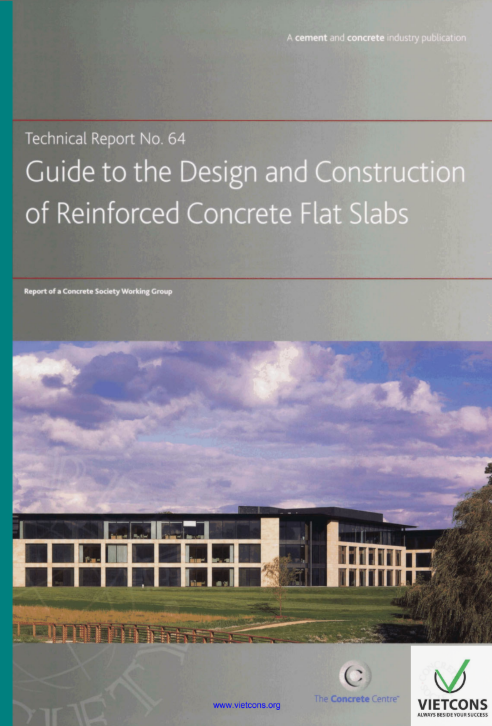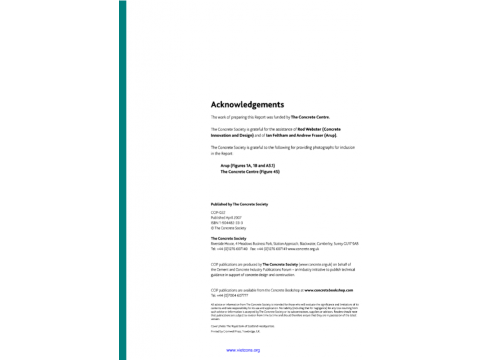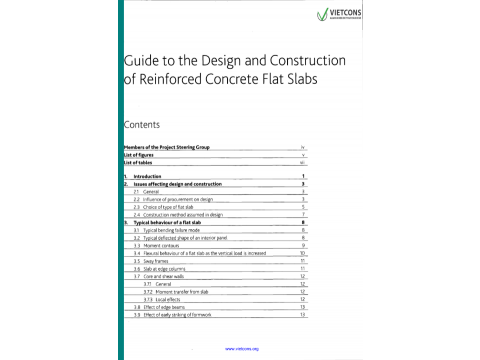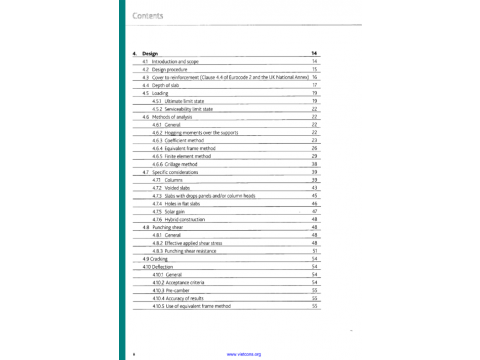TR64 | Guide to the design and construction of reinforced concrete flat slabs
Nhà xuất bản: The Concrete Centre
Năm xuất bản: 2007
LỜI GIỚI THIỆU
Báo cáo này cung cấp thông tin và thực tiễn tốt nhất hiện nay về thiết kế và xây dựng sàn phẳng bê tông cốt thép theo Eurocode 2 (BS EN 1992) và Tiêu chuẩn kỹ thuật bê tông kết cấu quốc gia (National Structural Concrete Specification). Báo cáo này dành cho các nhà thiết kế (cả công trình vĩnh cửu và tạm thời) đã có hiểu biết cơ bản về kết cấu.
Thiết kế sàn phẳng phù hợp với hầu hết các tình huống sàn và cũng thích hợp cho bố cục cột không đều, hình dạng sàn cong, dốc, v.v. Các lợi ích của việc chọn sàn phẳng bao gồm:
Giải pháp chiều sâu tối thiểu giúp giảm chi phí bao che và có lợi thế trong việc lập kế hoạch chiều cao.
Tốc độ thi công nhanh.
Linh hoạt trong bố cục mặt bằng, cả về hình dạng và bố trí cột.
Bề mặt phẳng, cho phép hoàn thiện sạch sẽ hoặc tự do bố trí hệ thống kỹ thuật.
Khả năng sử dụng các nhịp lớn kinh tế.
Có thể cắt lỗ, thay đổi và sửa chữa dễ dàng.
Khả năng lặp lại cao.
Giảm nhu cầu về dầm hạ cốt (và dầm nâng cốt).
Phạm vi và không gian cho việc sử dụng ván khuôn di chuyển (flying forms).
Khả năng cách âm tốt.
Phạm vi của Báo cáo này bao gồm sàn phẳng với bố cục cột vuông góc và không đều, bề mặt phẳng, sàn ô cờ (waffle slabs), sàn rỗng (voided slabs) và sàn có dầm biên. Cần lưu ý rằng sàn phẳng đặc với bề mặt phẳng là phổ biến nhất. Báo cáo này không đề cập đến thiết kế sàn dự ứng lực sau kéo.
MỤC LỤC
Members of the Project Steering Group
List of figures
List of tables
1. Introduction
2. Issues affecting design and construction
2.1 General
2.2 Influence of procurement on design
2.3 Choice of type of flat slab
2.4 Construction method assumed in design
3. Typical behaviour of a flat slab
3.1 Typical bending failure mode
3.2 Typical deflected shape of an interior panel
3.3 Moment contours
3.4 Flexural behaviour of a flat slab as the vertical load is increased
3.5 Sway frames
3.6 Slab at edge columns
3.7 Core and shear walls
3.7.1 General
3.7.2 Moment transfer from slab
3.7.3 Local effects
3.8 Effect of edge beams
3.9 Effect of early striking of formwork
4. Design
4.1 Introduction and scope
4.2 Design procedure
4.3 Cover to reinforcement (Clause 4.4 of Eurocode 2 and the UK National Annex)
4.4 Depth of slab
4.5 Loading
4.5.1 Ultimate limit state
4.5.2 Serviceability limit state
4.6 Methods of analysis
4.6.1 General
4.6.2 Hogging moments over the supports
4.6.3 Coefficient method
4.6.4 Equivalent frame method
4.6.5 Finite element method
4.6.6 Grillage method
4.7 Specific considerations
4.7.1 Columns
4.7.2 Voided slabs
4.7.3 Slabs with drops panels and/or column heads
4.7.4 Holes in flat slabs
4.7.5 Solar gain
4.7.6 Hybrid construction
4.8 Punching shear
4.8.1 General
4.8.2 Effective applied shear stress
4.8.3 Punching shear resistance
4.9 Cracking
4.10 Deflection
4.10.1 General
4.10.2 Acceptance criteria
4.10.3 Pre-camber
4.10.4 Accuracy of results
4.10.5 Use of equivalent frame method
5. Detailing
5.1 General
5.2 Edge beams
5.3 Column/slab joints
5.4 Distribution reinforcement
5.5 Punching shear reinforcement
5.6 Holes in slabs
6. Construction
6.1 General
6.2 Construction process
6.2.1 General
6.2.2 Construction loads
6.2.3 Column size
6.2.4 Cement types and concrete strength in practice
6.2.5 Reinforcement detailing
6.3 Striking of formwork
6.4 Pre-cambers
6.5 Proprietary punching shear systems
6.6 Edge beams
6.7 Concrete in the column/slab joint
6.8 Column head/drop panels
6.9 Quality of construction
7. References
Appendices:
A1. Ideal calculation sequence using non-linear plate design software
A2. Know your software - software features
A3. Preferred methods of construction: Views of two contractors
A4. Interpretation of grillage analysis results
A5. Example using Finite Element Analysis
>>> Xem thêm: Lịch khai giảng các khóa học siêu hot tại Vietcons Education!
CÁM ƠN QUÝ ĐỘC GIẢ ĐÃ QUAN TÂM VÀ THEO DÕI BÀI VIẾT CỦA VIETCONS.EDU.VN !
Các bạn có thể liên hệ trực tiếp Fanpage (https://www.facebook.com/VietConsEducation) của trung tâm để đặt câu hỏi. Chúng tôi sẽ giải đáp thêm cho bạn.
Quét mã QR









